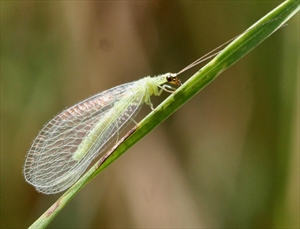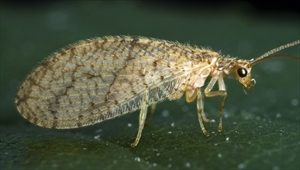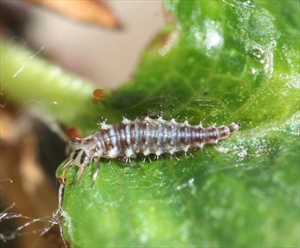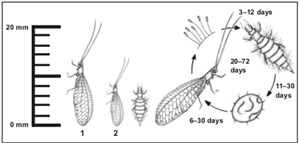Lacewings. There are two kinds: green (Photo 1) and brown (Photo 2). Green lacewings are more common and are also called 'common lacewings' or 'common green lacewings'. The two types, green and brown, not only differ in colour, but also in the venation of the wings. In this fact sheet we are dealing with green lacewings.
Pacific Pests, Pathogens and Weeds - Online edition
Pacific Pests, Pathogens & Weeds
Green lacewing (270)
Green lacewings belong to the family Chrysopidae. Brown lacewings belong to the family Hemerobiidae. Two common genera of green lacewings are Chrysoperla and Chrysopa.
Worldwide.
Both the adults (of some species) and the larvae prey on soft, sap-sucking insects, such as aphids, scale insects and many other insects (see under Impact).
Many species of green lacewings lay their eggs on thin stalks, singly or in batches (Photo 3), attached to the underside of leaves, wood, or the sides of buildings. Female lay up to 300 eggs over 3-4 weeks. After hatching, the larvae moult several times. When mature, they have long (up to 15 mm) narrow flattened bodies with stiff hair-like projections (Photo 4). They have chewing mouthparts, with pincers that protrude far in front of the head and are used to grip their prey; the pincers are hollow and, after injecting venom, are used to suck out the contents. After 2-3 weeks, the larvae pupate in thin silk cocoons for about 5 days.
The adults are bright green to green-brown, 15-20 mm long, with two pairs of wings that are about the same size, clear with characteristic networks of veins and cross veins; the wings are held tent-like over the body when at rest and reach beyond the end of the body. The golden eyes are large for the size of the head, and the antennae of green lacewings are characteristically long. The life cycle is about 20-70 days depending on temperature (Diagram).
Lacewings release a strong smelling chemical when disturbed, earning them the name 'stinkflies'.
Green lacewing larvae prey mostly on aphids, but also attack scale insects, mealybugs, leafhoppers, thrips, psyllids, whiteflies, caterpillars, moth eggs, many other small insects as well as mites. The larvae are fast moving and voracious feeders; they can eat up to 200 aphids a week. Adults of some species also feed on insects and mites, but others feed only on pollen, nectar and aphid honeydew.
There are companies supplying eggs of green lacewings for the control of pests, mostly aphids and mites (see under Management as Biocontrol Agents).
Look for adult green to greenish brown slender insects with long delicate wings with cross veins. Look for long antennae and distinctive golden eyes. Look for larvae which are like tiny alligators, with slender bodies, stiff hairs along their sides, and sickle-shaped mouthparts protruding from the head.
Lacewings can be attracted by planting sunflowers or dill, or by allowing weeds such as dandelions to thrive near to crops.
In many countries, however, green lacewings are reared as biocontrol agents, and released on crops rather than waiting for them to come naturally. They are used against aphids and mites, in particular. Most often they are sold as eggs.
The number of eggs released varies with the type of crop, the pest to be controlled and the number of pests present. The following is a guide only (suppliers' recommendations should be followed): (i) protected crops - 1000 eggs per 100 m2; (ii) field crops - 5000 eggs/ha. Preferably, two applications are made 10-14 days apart, in both situations.
Species of Chrysoperla and Mallada, are most often used in biocontrol programs, and the eggs of these can be purchased in many countries. In the USA, Chrysoperla rufilabris and Chrysoperla carnea are the most common species sold. Consignments of eggs are packed with rice hulls, and sprinkled over pest infested plants. The overall performance is said to be variable, and research into improving the performance of lacewings in IPM programs continues.
AUTHOR Grahame Jackson
Information from Chrysopia. Wikipedia. (https://en.wikipedia.org/wiki/Chrysopidae); and Neuroptera: lacewing and antlions. CSIRO. (http://www.ento.csiro.au/education/insects/neuroptera.html); and Queensland Museum (undated) Green lacewing. Queensland Government. (https://www.qm.qld.gov.au/Explore/Find+out+about/Animals+of+Queensland/Insects/Lacewings/Common+species/Green+Lacewings)/); and Lacewings (2019) Business Queensland. Queensland Government. (http://www.ento.csiro.au/education/insects/neuroptera.html). Photos 1,3&4 Whitney Cranshaw, Bugwood.org. Photo 2 David Cappaert, Michigan State University, Bugwood.org. Diagram. McDougall et al. (2017) Bunching vegetables: A field guide for the identification of insects, beneficials, diseases and disorders in Australia. NSW Department of Primary Industries. Australia.
Produced with support from the Australian Centre for International Agricultural Research under project PC/2010/090: Strengthening integrated crop management research in the Pacific Islands in support of sustainable intensification of high-value crop production, implemented by the University of Queensland and the Secretariat of the Pacific Community.








